Hoot! Hoot hoot! That classic sound an owl makes. This fascinating group of birds have some interesting habits and behaviors. Warning: some of their behaviors could be considered a little gross! Let’s take a look at some of the common owls of Central Oregon.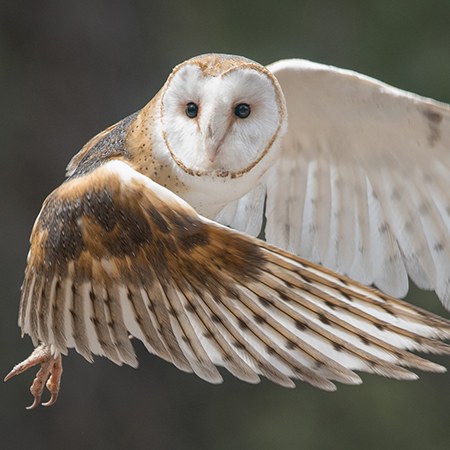
Barn Owls are quite distinctive with their white face, chest, and belly. A heart-shaped face with dark eyes, tawny-colored wings, and long legs complete their distinguishing features. Barn Owls are medium-sized, weighing about one pound. Females are showier than their male counterparts, with more red and a more heavily-spotted chest. In addition, these owls have a long, hissing shriek call that is quite spooky.
The Barn Owl’s ability to locate prey by sound alone is the best of any animal that has ever been tested in a lab. During these tests, they have been able to capture a mouse in compete darkness. As such, these birds are nocturnal. They hunt in open fields and meadows, mostly eating small mammals like rats and mice. Barn Owls eat their prey whole, then later cough up pellets containing the indigestible fur and bone.
These owls nest in tree cavities, caves, and buildings (including, yes, barns). The nest is made of the females’ regurgitated pellets, which she shreds with her feet and arranges into a cup. Barn Owls lay 2-18 eggs. They are usually monogamous and mate for life. After a pair forms, the males begin to bring prey to the female about a month before she lays eggs.
The greatest threat to Barn Owls is the development of agricultural land and the loss of suitable nesting sites.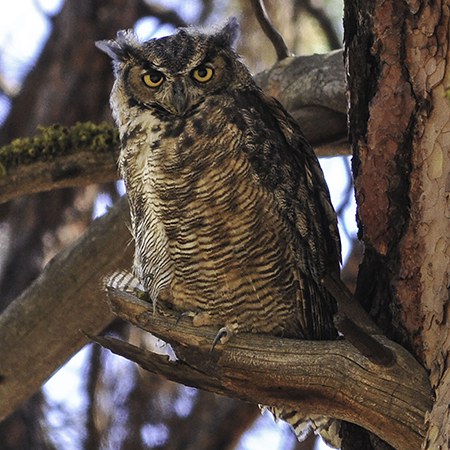
One of the most common owls in North America, you might have seen one after a mob of crows or ravens made such a racket that you went to take a look. Great Horned Owls are easily recognized by their broad ear tufts, as well as their large size—they are roughly 22” tall and weigh around 3.1 pounds! They have a grayish upperside with a barred underside. Their face is a tawny-orange color and they have piercing, yellow eyes. These owls have incredibly soft feathers that help them fly quietly towards unsuspecting prey. They make that classic sound an owl makes—a deeply muffled hooting call.
Great Horned Owls have the most diverse diet of all North American raptors. They mostly eat mammals and birds, including squirrels, rabbits, skunks, voles, ducks, ravens, doves, bats, and more. These owls hunt mostly nocturnally in woods, fields, and forest edges. Once they spot prey, they will chase it in flight.
Roosting occurs in trees, snags, thick brush, cavities, ledges, and human structures. Great Horned Owls generally adopt a nest built by another (usually Red-Tailed Hawks, ravens, herons, and squirrels) and seldom reuse the same nest. They lay 1-4 eggs.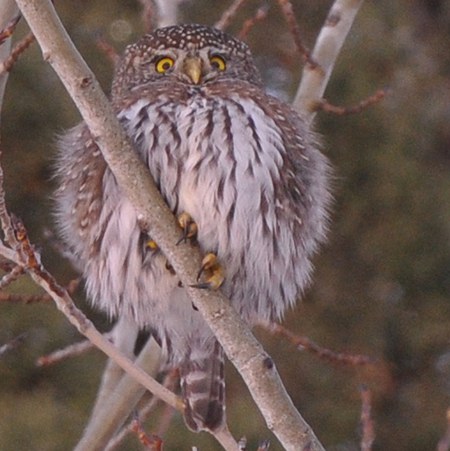
These small guys have a wingspan of 12” and come in at a mere 2.5 ounces (about half the weight of a baseball). They are mostly dark brown and white, with belly streaks, a spotted crown, and white eyebrows. Northern Pygmy-Owls also have a pair of spots on the back of their neck that resemble eyes, thought to help foot attackers and mobbers into thinking they’re being watched. These owls have high-pitched, evenly spaced tooting calls.
Northern Pygmy-Owls love to eat songbirds like chickadees and warblers! They also eat hummingbirds, shrews, moles, insects, and reptiles. They can take prey that is up to three times their own size. Unusual for an owl, they hunt during the day. These owls will often cache their food in tree cavities or hang them on thorns.
These owls can be found in forests. They nest in holes in snags that are created by woodpeckers or caused by rot. They have 2-7 eggs per clutch. The female incubates the eggs, while the male hunts and brings food to the female and the nestlings.
Their main predators are larger owls and raptors, as well as weasels. Northern Pygmy-Owls need snags and woodpeckers in order to survive.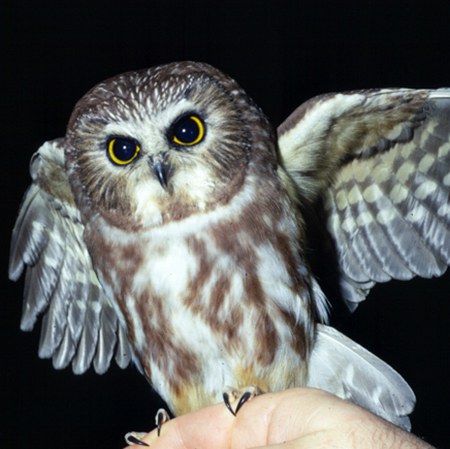
These small owls, weighing 2.8 ounces and with a wingspan of 17 inches, have oversized heads and bright yellow eyes. They look quite different as fledglings than they do as adults. Adults have wide brown vertical streaks on their chests and white spots on their shoulders. In comparison, fledglings have reddish-orange chests with brown wings. Both have a prominent white “V” on their face. Their call is a whistled “too-too-too” that is repeated about two times per second.
The main prey of Northern Saw-whet Owls is mice, which they typically eat in pieces over two days. They hunt in wooded habitat with an open understory. These owls are highly nocturnal and seldom seen as they roost in dense conifers during the day.
They nest in holes created by others, usually Northern Flickers and Pileated Woodpeckers. The entrance to their nest is usually 2-3 inches across. They lay 4-7 eggs. Females perform all of the incubation and brooding while the male does all of the hunting.
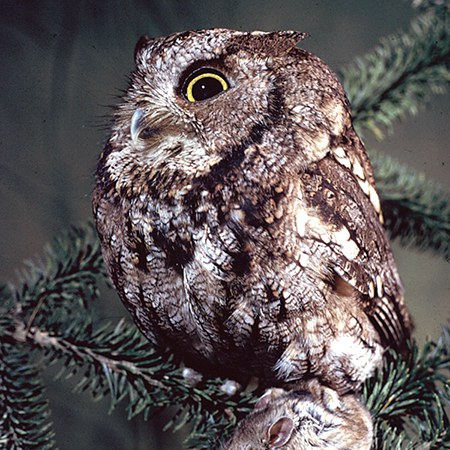
This small and stocky owl weighs around five ounces, about the same as a deck of cards. Their coloration varies from brownish to grayish, with Western Screech-Owls in the Pacific region the darkest. Regardless of color, their feathers always have an intricate pattern that helps them blend in with trees. Contrary to what you might think, they have high, short toot calls that speed up.
Western Screech-Owls have an incredibly varied diet, from worms, insects, and crayfish, to mice, rats, bats, and the occasional rabbit. They hunt nocturnally in the woods and deserts of western North America.
These owls prefer forested areas to roost, especially deciduous trees that line streams and canyon bottoms. Western Screech-Owls nest in tree cavities, mostly created by woodpeckers, but also naturally-created cavities. Breeding pairs are “socially monogamous,” which means both will mate outside their pair, but will raise their young together. Pairs are also known to preen one another and to sing duets together. They lay 2-7 eggs per clutch.
In the Pacific Northwest, Western Screech-Owls are vulnerable to predation from Barred Owls, which recently arrived in the area. In addition, their streamside habitat is highly sought after by humans, making the possibility of development a concern.
Sources: The Cornell Lab of Ornithology and The Sibley Field Guide to Birds of Western North America.
Learn more:


